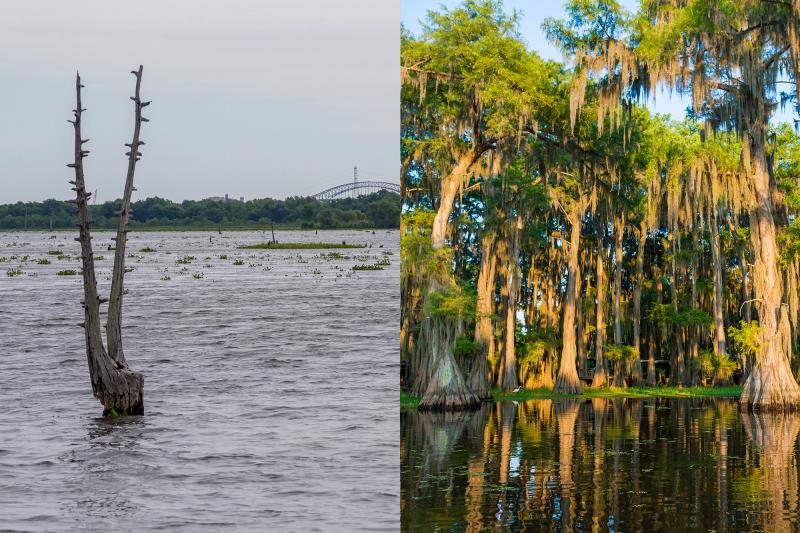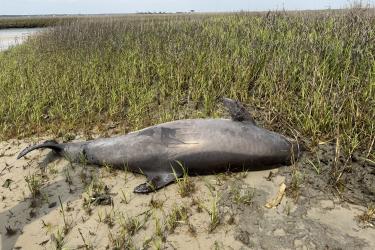Today, locals in New Orleans’ Lower Ninth Ward call the Bayou Bienvenue Wetlands Triangle a “ghost swamp.” The area was formerly a cypress forest with trees so close together people could canoe through them without paddles. Now, standing by a sign commemorating the forest, you'll see open water with a few bone white tree trunks jutting out. Through its grant program for underserved communities under the Bipartisan Infrastructure Law and Inflation Reduction Act, NOAA Fisheries is providing $1.2 million to galvanize the efforts of local groups to restore the habitat.
The original Bayou Bienvenue forest stood within the 30,000-acre Central Wetlands Unit in Orleans and St. Bernard Parishes. It provided residents with a place to fish and hunt, collect wild onions and herbs, and escape from the heat and noise of the city. Its towering cypress trees and live oaks, together with the marsh grass and aquatic plants, also buffered the wind and waves from hurricanes.
However, after the construction of a massive shipping channel through the wetlands in the 1960s, salt water entered the ecosystem. As the salt killed off the freshwater plants, the channel, dubbed the “Hurricane Highway,” also gave storm surge coming off the Gulf of Mexico a direct path into the wetlands and surrounding community. In 2005, storm surge from Hurricane Katrina inundated the area in up to 15 feet of saltwater, destroying homes and killing many people. In the 18 years since then, despite the development of a restoration plan and efforts to revitalize the communities, both remain a shell of their former selves.
With new NOAA funding, these groups, working in partnership with foundations and city and state governments, will:
- Plant 15,750 trees, 18,000 plugs of marsh grass, and 20 plots of aquatic vegetation in the Central Wetlands Unit.
- Create a nature-based engineering and design plan for additional restoration work in the Bayou Bienvenue Wetlands Triangle
- Engage residents of the Lower Ninth Ward and St. Bernard Parish in all aspects of restoration work and project planning to improve the health and sustainability of the community
“We feel grateful that we're stewards of these congressionally-appropriated dollars for coastal and community resilience,” says John Barco, Marine Habitat Resource Specialist for NOAA. “We're excited to work with these partners and the community to build off the work they’ve already accomplished.”
Changes to Habitat Led to Disaster for Low-Income Communities
In December 1957, government officials kicked off the construction of the Mississippi River Gulf Outlet (MRGO, pronounced locally as “Mr. Go”) with the crack of dynamite blowing up cypress trees. “The 76-mile shipping channel, which was dug to provide a shortcut between the Gulf of Mexico and Port of New Orleans, moved more earth than the construction of the Panama Canal,” says Amanda Moore, Director of the National Wildlife Federation’s Gulf Program which is supporting the Bayou Bienvenue Wetlands Triangle design project. “There was a lot of promise of economic prosperity, but it never came to be.”
“The channel wasn’t well used and it ended up impacting more than 1 million acres of coastal habitat in the greater New Orleans area,” says Moore, who also leads advocacy efforts for the restoration of the wetlands degraded by MRGO. “Unfortunately, it took one of the worst disasters in U.S. history—Hurricane Katrina—to get the channel closed. Katrina’s storm surge caused multiple levee breaks, up and down MRGO in Orleans and St. Bernard Parish. It forever changed the communities.”
With Hurricane Katrina, the population of the Lower Ninth Ward dropped from 14,000 to 4,000 residents. More than 90 percent of the population is African American, with one-third of residents living below the poverty line. Census data shows residents of the neighborhood and surrounding areas experience some of the worst economic impacts caused by natural hazards in the country.
Changing Tides
MRGO’s outlet to the Gulf of Mexico was blocked in 2009. The levees around the Central Wetlands Unit were rebuilt to withstand 100-year flooding events. Over the years, the salinity dropped to levels where freshwater plants could survive. In 2012, Louisiana developed a master plan for the restoration of the Central Wetlands Unit, but no funding source was identified.
Nevertheless, the Central Wetlands Reforestation Collective, which includes the Coalition to Restore Coastal Louisiana (CRCL), Pontchartrain Conservancy, Common Ground Relief, Lower 9th Ward Center for Sustainable Engagement and Development (CSED), the Louisiana Department of Agriculture and Forestry, and the Meraux Foundation, began planting trees and marsh grasses.
With funding from NOAA, the Collective as well as the City of New Orleans, National Wildlife Federation, Water Institute, and Nunez Community College, will now be able to kickstart major restoration efforts.
“What feels most exciting to me about this project is the level of collaboration,” says Charlotte Clarke, Co-Director of Common Ground Relief, a member of the Collective, which has been doing restoration work in Louisiana for 15 years. “We're facing a really urgent climate crisis, so emphasizing shared goals is a lot more powerful than competing for resources. We’re building a future that's actually survivable for us all.”
In addition to supporting replanting efforts and design work, the grant will fund some of the smaller organizations’ budgets for 4 years. It will allow them to hire additional staff to manage restoration work and community outreach.
Reconnecting People with the Environment
Getting buy-in from local residents will be crucial to the success of the restoration efforts. “In this area, there has been this history of building infrastructure and disconnecting the community from the natural environment,” says Austin Feldbaum, Hazard Mitigation Director for the City of New Orleans. “So it's important for us to reconnect the two.”
Outreach efforts for the replanting work and design project are being led by the Lower 9th Ward Center for Sustainable Engagement and Development (CSED). The center helps educate residents about the environment so they can contribute to restoration work and advocate for projects that address their needs.
“Our community is realizing we have rights,” says Arthur Johnson, CEO of CSED, who was born in Washington, D.C., but grew up visiting his grandmother in the Lower Ninth Ward. “When public and private entities get together to make a plan for how to deal with a problem, we shouldn’t be left out of the equation.”
“In the past, you had scientists and academics up on the podium in town hall meetings and the audience was somewhat intimidated. We started saying, maybe you all need to come to us to where we're most comfortable. These people do bring a lot to the table, but maybe they never experienced a formal education.
“Through conversations, workshops, and activities for the young and the not so young, we're starting to see the connections. For example, bringing up why it is important to plant trees. We need to plant trees not only because we lost trees, but because we need trees for health—mental, emotional, and physical. The Central Wetland is kind of their playground, but it's also an emotional thing. It's the place where they feel most protected because it's natural.”
The Benefit of Healthy Wetlands
Staff and volunteers working with Central Wetlands Reforestation Collective will begin planting trees and grasses in November. Meanwhile, CSED and NWF are conducting community outreach for the Bayou Bienvenue Wetlands Triangle project while the Water Institute facilitates a structured and collaborative process to develop the restoration planning and design. The planning and design project is led by the City of New Orleans with additional funding provided by the National Fish and Wildlife Foundation.
Restoring wetlands to a healthy state will bring many benefits to people and the ecosystem. The partners aim to restore a range of habitat types—cypress and tupelo swamps, higher elevation ridges with live oaks, and wetlands with grasses and aquatic plants. They will bring back a variety of wildlife and create more layers of storm protection.
“Bringing back a more mature, advanced ecosystem provides habitat for more species of fish, birds, and mammals,” says Michael Biros, Restoration Programs Director for Coalition to Restore Coastal Louisiana. “It will also function better in terms of filtering out pollutants which would normally go back into the food chain and eventually to people.”
“Healthy wetlands are a part of Louisiana’s multiple-lines-of-defense strategy—the levees alone are not the full solution to coastal risks,” says Feldbaum. “As storm surge impacts get more intense over the coming century, having the Central Wetlands Unit already inside the levee raises the stakes even more to keep it healthy,” says Michael Hopkins, Coastal Program Director for Pontchartrain Conservancy.
“The forest is also cooling, which is really important as we all noticed this summer,” says Biros. On August 27, New Orleans shattered its all-time high temperature record at 105°F.
The wetlands give local people and visitors a chance to get outdoors to fish, kayak, and observe wildlife. It may also help alleviate some of the fear and anxiety felt by community members since Hurricane Katrina. “There’s fear of water, fear of storms, fear of the future, and nostalgia for what was lost,” says Biros. “I'm very hopeful that these types of projects will help communities overcome that fear and have a say in what their future looks like. I think putting a tree in the ground in the face of these extreme existential challenges is a radical act.”
“I had accepted it being destroyed but I never turned my back on it,” said John Taylor, a long-time resident of the Lower Ninth Ward and outspoken advocate for the Bayou Bienvenue Wetlands. Taylor grew up four blocks from the wetlands and spent his youth fishing and hunting in cypress forest. “The swamp was my therapy. Now people are talking about restoring this and you do whatever you can to help a good friend.” Sadly, Taylor passed away in March, but a radio interview and video testimony recorded for an exhibit at the Ogden Museum of Southern Art detail his experiences in the wetlands and his efforts to restore them. “I know if I die the youngsters got my slack,” said Taylor. “They putting it together. It'll be there.”
Building Towards a Sustainable Future
Common Ground Relief, the Coalition to Restore Coastal Louisiana, and Pontchartrain Conservancy, are all recruiting volunteers to help with plantings this fall. “We work with all kinds of volunteers,” says Clarke. “We mainly focus on local students, but we also work with people from across the country who want to learn about issues that are impacting us here.”
“It feels good to be bringing back the environment, to get a little bit muddy, to get your hands dirty,” says Blaise Pezold, Coastal and Environmental Program Manager for Meraux Foundation, which is providing funds and land for replanting. “But to be able to correct some of the wrongs that happened over hundreds of years feels really, really good.”
“I think the thing we take away from this is the impact on people,” says Johnson. “Not only from the projects now, but future projects too. For young people, it's to understand there's a role for them to play in this. For example, we had a young man in our environmental research internship who loves basketball. He said the only reason he's in the program is because his mother said he had to be in it. However, after the internship, he said wants to be an athlete—and a scientist. I said you can do both in college.”
NOAA recently announced a $45 million funding opportunity for projects that will advance the coastal habitat restoration and climate resilience priorities of underserved communities and tribes. Applications are due by December 19, 2023.









